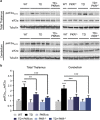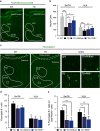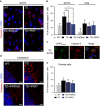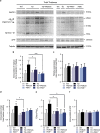PKR downregulation prevents neurodegeneration and β-amyloid production in a thiamine-deficient model
- PMID: 25590804
- PMCID: PMC4669750
- DOI: 10.1038/cddis.2014.552
PKR downregulation prevents neurodegeneration and β-amyloid production in a thiamine-deficient model
Abstract
Brain thiamine homeostasis has an important role in energy metabolism and displays reduced activity in Alzheimer's disease (AD). Thiamine deficiency (TD) induces regionally specific neuronal death in the animal and human brains associated with a mild chronic impairment of oxidative metabolism. These features make the TD model amenable to investigate the cellular mechanisms of neurodegeneration. Once activated by various cellular stresses, including oxidative stress, PKR acts as a pro-apoptotic kinase and negatively controls the protein translation leading to an increase of BACE1 translation. In this study, we used a mouse TD model to assess the involvement of PKR in neuronal death and the molecular mechanisms of AD. Our results showed that the TD model activates the PKR-eIF2α pathway, increases the BACE1 expression levels of Aβ in specific thalamus nuclei and induces motor deficits and neurodegeneration. These effects are reversed by PKR downregulation (using a specific inhibitor or in PKR knockout mice).
Conflict of interest statement
Professor Jacques Hugon is a consultant for Roche, Sanofi, Novartis, Xigen, Eisai and Lundbeck. Dr. Claire Paquet is a consultant for Lilly and Novartis. Dr. Julien Dumurgier is a consultant for Novartis. Dr. Patrick Bernardelli, Dr. Véronique Taupin, Dr. Thomas Rooney and Dr. Laurent Pradier are fully employed by Sanofi. The remaining authors declare no conflict of interest.
Figures








Similar articles
-
Oxidative stress increases BACE1 protein levels through activation of the PKR-eIF2α pathway.Biochim Biophys Acta. 2012 Jun;1822(6):885-96. doi: 10.1016/j.bbadis.2012.01.009. Epub 2012 Jan 28. Biochim Biophys Acta. 2012. PMID: 22306812
-
Activation of double-stranded RNA-activated protein kinase by mild impairment of oxidative metabolism in neurons.J Neurochem. 2007 Dec;103(6):2380-90. doi: 10.1111/j.1471-4159.2007.04978.x. Epub 2007 Oct 22. J Neurochem. 2007. PMID: 17953670
-
Neuroinflammation and Aβ accumulation linked to systemic inflammation are decreased by genetic PKR down-regulation.Sci Rep. 2015 Feb 17;5:8489. doi: 10.1038/srep08489. Sci Rep. 2015. PMID: 25687824 Free PMC article.
-
Selective response of various brain cell types during neurodegeneration induced by mild impairment of oxidative metabolism.Neurochem Int. 2004 Jul-Aug;45(2-3):361-9. doi: 10.1016/j.neuint.2003.09.008. Neurochem Int. 2004. PMID: 15145550 Review.
-
PKR involvement in Alzheimer's disease.Alzheimers Res Ther. 2017 Oct 5;9(1):83. doi: 10.1186/s13195-017-0308-0. Alzheimers Res Ther. 2017. PMID: 28982375 Free PMC article. Review.
Cited by
-
The Sixth Sense: Self-nucleic acid sensing in the brain.Adv Immunol. 2024;161:53-83. doi: 10.1016/bs.ai.2024.03.001. Epub 2024 May 3. Adv Immunol. 2024. PMID: 38763702 Free PMC article. Review.
-
PKR deficiency alters E. coli-induced sickness behaviors but does not exacerbate neuroimmune responses or bacterial load.J Neuroinflammation. 2015 Nov 19;12:212. doi: 10.1186/s12974-015-0433-2. J Neuroinflammation. 2015. PMID: 26585788 Free PMC article.
-
PKR modulates abnormal brain signaling in experimental obesity.PLoS One. 2018 May 24;13(5):e0196983. doi: 10.1371/journal.pone.0196983. eCollection 2018. PLoS One. 2018. PMID: 29795582 Free PMC article.
-
PKR kinase directly regulates tau expression and Alzheimer's disease-related tau phosphorylation.Brain Pathol. 2021 Jan;31(1):103-119. doi: 10.1111/bpa.12883. Epub 2020 Aug 6. Brain Pathol. 2021. PMID: 32716602 Free PMC article.
-
BACE1 Translation: At the Crossroads Between Alzheimer's Disease Neurodegeneration and Memory Consolidation.J Alzheimers Dis Rep. 2019 May 15;3(1):113-148. doi: 10.3233/ADR-180089. J Alzheimers Dis Rep. 2019. PMID: 31259308 Free PMC article. Review.
References
-
- Baker KG, Harding AJ, Halliday GM, Kril JJ, Harper CG. Neuronal loss in functional zones of the cerebellum of chronic alcoholics with and without Wernicke's encephalopathy. Neuroscience 1999; 91: 429–438. - PubMed
-
- Calingasan NY, Huang PL, Chun HS, Fabian A, Gibson GE. Vascular factors are critical in selective neuronal loss in an animal model of impaired oxidative metabolism. J Neuropathol Exp Neurol 2000; 59: 207–217. - PubMed
-
- Ke ZJ, Gibson GE. Selective response of various brain cell types during neurodegeneration induced by mild impairment of oxidative metabolism. Neurochem Int 2004; 45: 361–369. - PubMed
Publication types
MeSH terms
Substances
LinkOut - more resources
Full Text Sources
Other Literature Sources
Molecular Biology Databases

